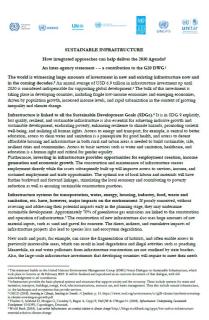
The world is witnessing large amounts of investment in new and existing infrastructure now and in the coming decades. An annual average of USD 6.9 trillion in infrastructure investment up until 2030 is considered indispensable for supporting global development. The bulk of this investment is taking place in developing countries, including fragile low-income economies and emerging economies, driven by population growth, increased income levels, and rapid urbanization in the context of growing inequality and climate change.
Infrastructure is linked to all the Sustainable Development Goals (SDGs). However, infrastructure systems for transportation, water, energy, housing, industry, food, waste and sanitation, etc. have major impacts on the environment. At the same time, climate change-related risks threaten infrastructure itself. Infrastructure development can also have complex social impacts related to displacement, land rights, cultural heritage, indigenous peoples, gender equality, employment, public health, safety and security, sexual exploitation and abuse, and other issues.
Against this backdrop, this interagency statement calls for integrated approaches to infrastructure developement to optimize outcomes by considering the interconnections between different infrastructure systems and sectors (including natural infrastructure such as landscapes and ecosystems), aspects of sustainability (social, environmental, and economic), spatial scales (national, regional, local), and governance frameworks (inter-ministerial coordination). The listed organizations express interest in linking sustainable infrastructure considerations to their respective or collaborative programmes; to support the development, promotion and improvement of integrated infrastructure planning tools, guidelines, norms, and standards, and their application to upstream planning; and to facilitate related knowledge sharing, human capacity building, and institutional arrangements.
